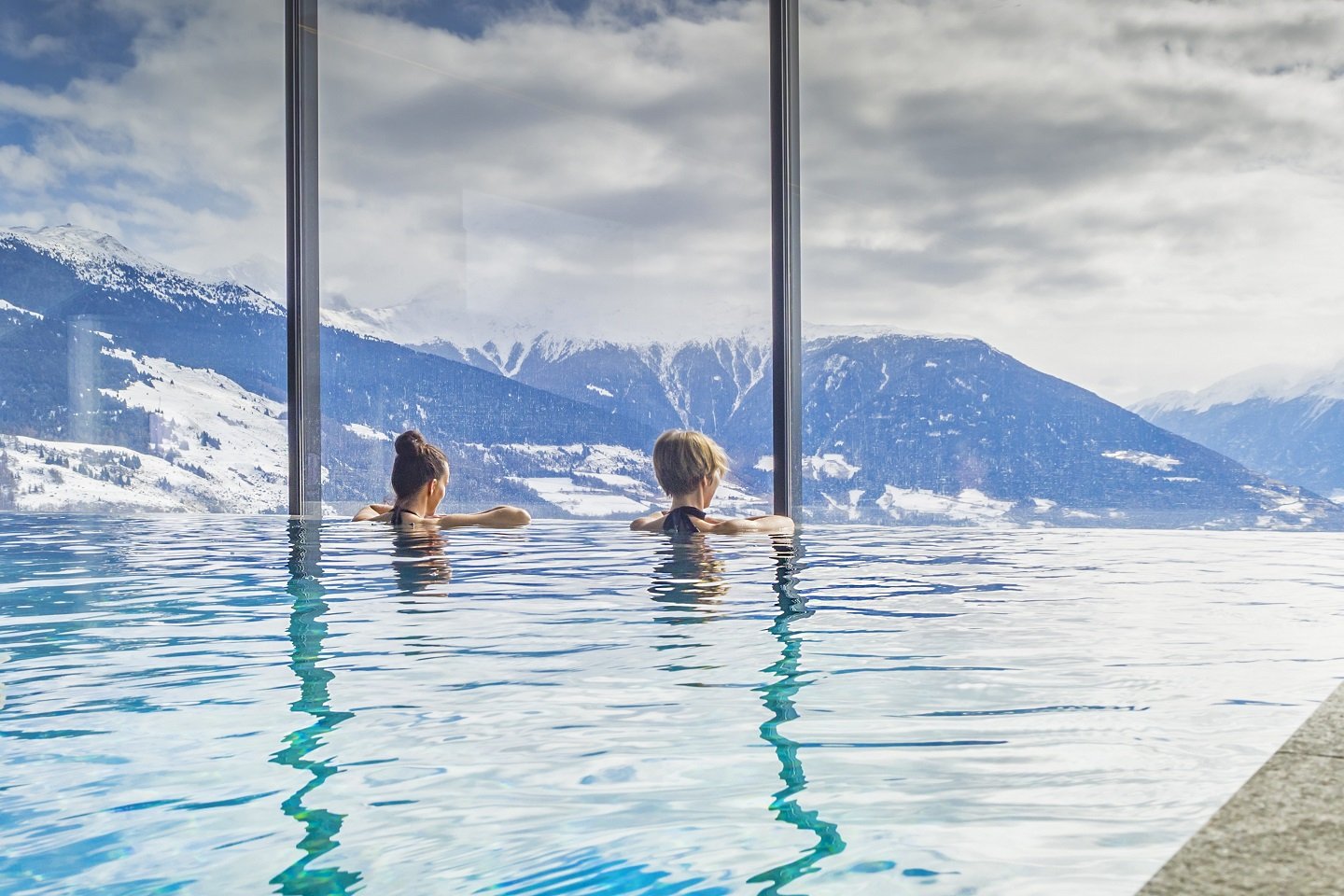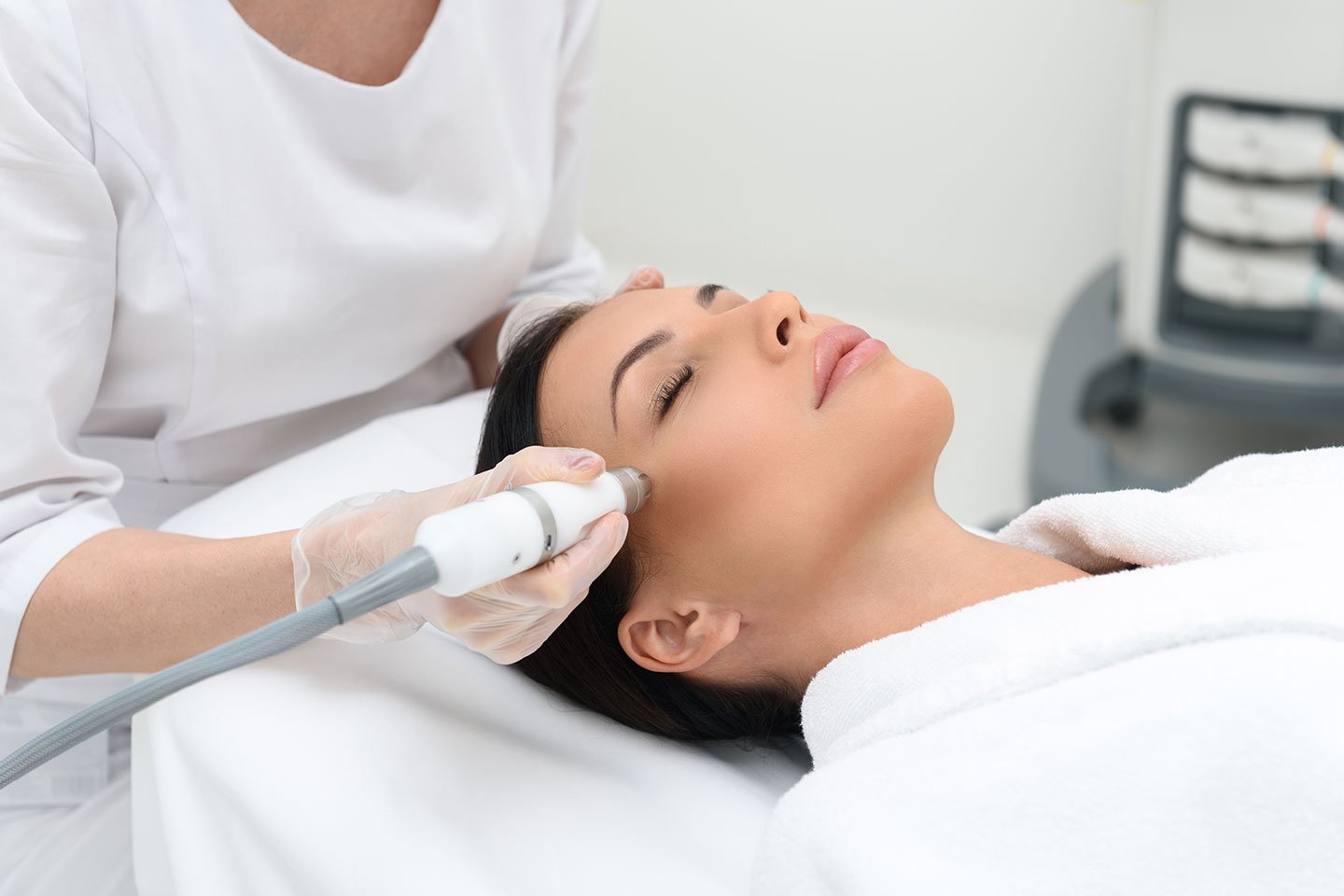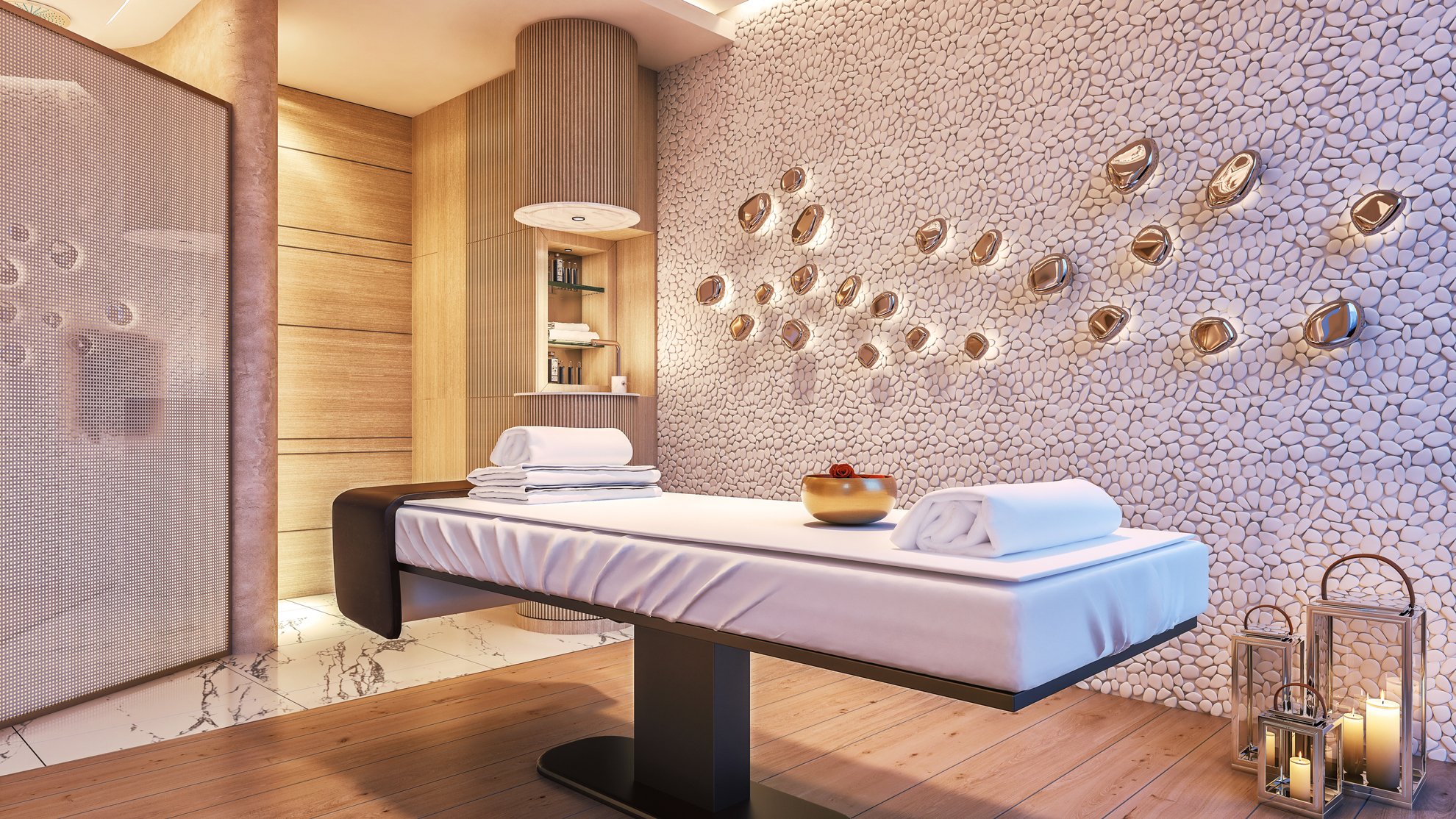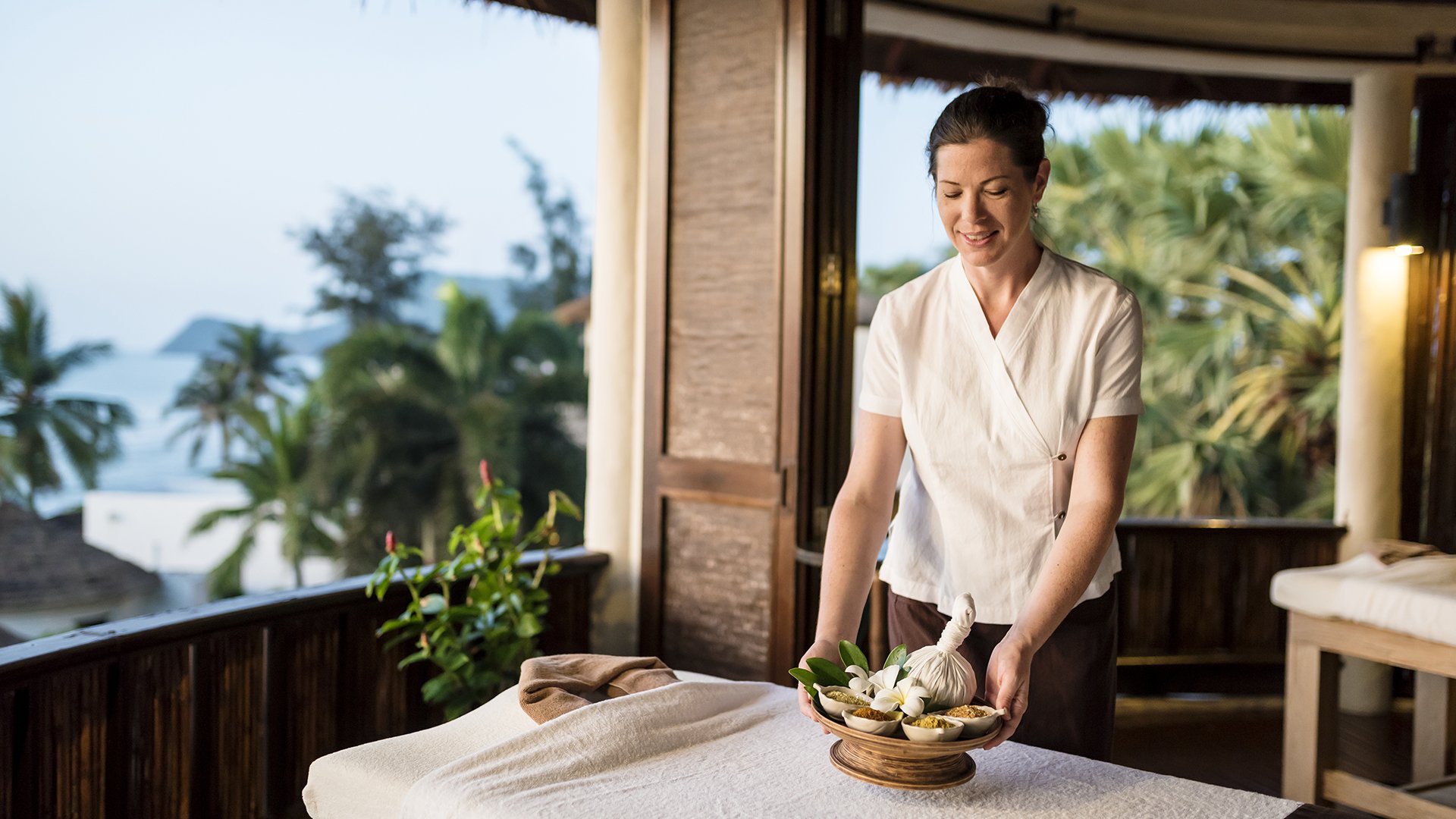This article aims to give you a complete overview of working in the spa & wellness industry to help you understand your potential career path and work environment. We will look at spa & wellness trends that drive the industry and professional opportunities in this field.
What is spa management?
Spas are thriving businesses that have many working parts, including staff that carry out spa services or handle operations, products and equipment necessary for treatments and guests that come for various spa treatments. Similar to other areas within the hospitality and tourism industries, the best spas offer quality treatments, a list of amenities and superior customer service.
What is spa management? This management team would be responsible for running and overseeing the many working parts of the spa. The main goal is to ensure that all guests have the best spa experience possible, and a good spa will look for ways to improve and be innovative.
Spa and wellness management can differ depending on the setting, the size of the spa and other factors. For example, a freestanding spa would have different needs than a spa within a hotel, and a medical spa would differ from a beauty spa. Also, the size and focus of the spa could determine whether management stayed more behind the scenes or was more front-facing with the guests. Nonetheless, there are certain duties that are similar among spa management across different settings. These may include:
- Ensuring the spa has proper staffing to carry out its services
- Managing the staff and ensuring proper training
- Working with vendors to supply products and equipment for spa services and amenities
- Maintaining the business budget
- Managing spa marketing efforts to bring in more guest visits
READ: What is Spa Management?

Spa & wellness business types
Not all spas and wellness businesses are alike. Just as you will find many types of hotels, there are diverse spas within the hospitality, wellness and tourism industries. A career in spa management could take you to different kinds of settings and brands. This could be beneficial as you could match your skills and preferences to the type of wellness business that fits you best.
In some cases the spa is an extra service offered to guests of a business. In other cases, the spa is the main focus of the business.
Spa types include day spas, hotel spas, destination spas, medical spas and more.
Day Spas
As the name implies, day spas are places to visit without accommodations attached to the spa. These are businesses that locals and tourists could visit, generally to receive treatments focused on relaxation, personal care and beauty.
Day spas tend to offer relaxation and wellness treatments like massages and baths. They often include salon services to care for nails and hair, and their offerings often include skin treatments like facials. Each day spa may have a certain brand, focus or setting that determines the types of treatments offered and unique offerings. For example, you may find an organic day spa that uses organic products or a spa with specialty healing baths and wraps. Many of these spas include features like steam rooms, saunas and hot tubs.
Hotel Spas
Hotel or resort spas offer the relaxation and treatments of a spa directly on site at your accommodations. This becomes one of the services that a hotel or resort can offer to its guests, which is especially a good fit for high-end brands.
Services of each spa will vary by the hotel and brand it is attached to and the type of clientele it is trying to attract. Generally, this type of spa would offer relaxing and rejuvenating treatments to improve a vacation, also providing treatments focused on enhancing beauty and helping guests to look and feel their best for any occasion. Spa hotels tend to make guests feel special through a first-class experience.
These spas generally offer the typical treatments and amenities you would expect, such as a sauna, salon and massages. Then, other services become highly customized by the brand and the destination and experience being created at this hotel. You may expect seaweed wraps and sea salt treatments at hotels near the ocean or healing treatments offered at a wellness hotel focused on rejuvenation and health.
Destination Spas
While a hotel may include spa services in its offerings, a destination spa is a vacation spot with the spa as the main attraction of the stay. These are generally resorts that people visit specifically for the spa services of the destination. People might visit a hotel spa while on a vacation that involves various activities. But people visit a destination spa to spend the vacation using the spa services.
Guests may visit this type of spa for certain goals such as to relax, heal, improve health and wellness, rejuvenate or have a medical procedure. Some of these spas were built around a natural feature like mineral springs, while other ones create their own services.
These may include services that help people detox and get a fresh start on a healthy lifestyle. These could include fitness programs, healthy meals and education on health and wellness.
Medical Spas
Medical spas combine medical applications, which are normally conducted in a medical practice, with the experience of a day spa.
Some hotel operators are establishing themselves as spa destinations that are primarily medically oriented and have the best specialist staff. The guests stay there for some time, in order to recover for instance after a cancer treatment, to detoxify the body, to optimize the metabolism or to strive for a medical weight loss. To properly integrate these medical applications into spa settings, well-trained professionals and managers are needed.
There are also many medical spas, or medspas or medi-spas, that center on anti-aging and aesthetic treatments instead of going to a doctor’s office. This type of medical spa could offer a broad range of services. Some services target lines, wrinkles, sagging and other signs of aging on the skin. Others may help a person lose weight, detox or remove unwanted hair, scars, stretch marks or veins. Treatments could include fillers, medical facials, laser therapies and others.
READ: What is a medical Spa?
Complementary and Alternative Health Spas
While Western medicine primarily treats symptoms, it is complementary and alternative medicine (CAM) that has helped connect medicine with spa or wellness providers. These are natural or holistic methods that focus on underlying causes of health concerns or on using natural methods of promoting wellness. CAM treatments can include chiropractic, acupuncture, herbal teas and lotions, dietary changes, water cures and other approaches. Some of these spas have a holistic focus that includes the mind, body and spirit into wellness ideas. For example, these spas could include meditation and yoga into their services.
Another popular spa type in this category is an Ayurvedic spa, which follows practices of the traditional Ayurveda medicine system. These spas include holistic views of wellness and may include a variety of Ayurvedic treatments including yoga, herbs, dietary changes and detoxification.
These spas require professionals within each branch of CAM to practice their specialty with guests. They should also have an atmosphere that promotes wellness, meditation and healing.
Club Spas
These spas are generally part of fitness clubs, so they offer another service to members or visitors who come to focus on their fitness and health. These spas are like day spas because they are not attached to overnight accommodations, and they offer various spa services for a quick daytime visit. Unlike day spas which are often freestanding businesses, these spas are part of the fitness club business.
The spa services offered in these businesses usually follow the theme of fitness and wellness. They provide an additional service for people who are paying for a gym or health club membership, yet these businesses may offer day passes to non-members.
These health and fitness-oriented spas generally have steam rooms, saunas and hot tubs. They may also include swimming pools, massages, skin and body treatments, and holistic treatments. In addition to the spa services, members generally have access to other features like the gym, a lounge and a café or bar. Some may include other services common to traditional spas, such as a salon.
Health and Fitness Spas
Guests may want to visit specialized health and fitness spas to improve their health or reach a goal like losing weight. These spas could include health farms, health spas or boot camp spas. They often include a customized approach that helps each person reach health goals through fitness classes, diet and exercise coaching, calorie-controlled meals and other features. These spas may also provide relaxing treatments to use as a break from nutrition and fitness programs.
READ: Health spa - lessons from 3 Swiss luxury hotels
Health and fitness spas require professionals in these fields to offer nutritional meals, fitness classes and other specialized services.

Spa & wellness industry
An industry in growth
Aesthetic medicine and cosmetic beauty treatments as well as the increasing wellness trend in highly developed countries are driving the medical spa and wellness market. However, the high cost of medical spa treatments is limiting market growth, particularly in developing countries. A large portion of people is getting older, which could be a prime audience for medical spa treatments that focus on anti-aging.
In 2017, North America was the dominant sales driver, fueled by the growing wellness trend and the early introduction of new technologies in this area.
However, the Asia-Pacific region is expected to reach the highest CAGR between 2018 and 2025 as incomes increase in populous countries such as India and China. In addition, medical tourism will also stimulate market growth. India is the fastest growing country in the Asia-Pacific medical spa market and is expected to grow at an average rate of 14.2 percent between 2018 and 2025.
The health and wellness spa industry also expects to include virtual reality just as it is becoming increasingly popular in other segments of the population. This form of technology fits the spa industry because it can facilitate the experience of relaxing and getting away from a person’s normal setting and state of mind. Through VR glasses, a person can escape to somewhere new.
In the global spa and wellness industry, spa services are expected to expand to more settings such as airlines including them in airports and through on-flight massages. Also, vacation packages are enticing visitors through spa services combined with other leisure and wellness activities.
READ: Spas around the world
Rising demand for Medical treatments in spa management
In times of high strain, stress and constant digital availability, the need for one's own well-being and self-care becomes more and more important. The demand for medical services in the hospitality and tourism sector is rising accordingly. People are also looking to this area for anti-aging treatments. Medical spas allow people to get these treatments in a private, relaxing setting away from the doctor’s office. They can feel pampered and rejuvenated while leaving the spa looking more youthful and fresh.
The global medical spa market was estimated at $11.1 billion in 2017 and is expected to reach $27.6 billion by 2025, representing an average annual growth rate (CAGR) of 12.2 percent over the entire period, according to Allied Market Research.
The Global Wellness Institute stated that wellness tourism is expected to grow at an average annual rate of 7.5 percent through 2022. Wellness accounts for 58 percent of global health spending. This is a market that deserves attention. Since medical spas and other types of spas are included in wellness tourism, you could expect increasing spa management jobs within this area.

Swiss Spa & Wellness industry and link to the hospitality industry
As people around the world are looking for more solutions to their stress and mental health problems, the spa and wellness industry is responding. The market shows that people are responding to this solution, as the global wellness tourism industry was worth $563 billion in 2015. Switzerland is considered at the front of this movement, as it offers amazing natural landscapes, natural mineral springs and a culture that values self-care. The country includes many luxury retreats with clean air and mountain landscapes. Switzerland has a long history of wellness retreats and natural water treatments, so it is has the expertise and experience to continue its traditions and bring them forward into the modern industry.
Swiss hotels are medical spa champions
Switzerland can look back on a long history of a medical host culture. This goes back to the times of tuberculosis sanatoriums, where guests from all over the world have recovered in the fresh mountain air and with water cures of bubbling mineral springs.
Today's ultra-modern luxury medical spas in Switzerland are the result of this long-standing tradition of relaxation. To this day, Swiss hotels and spa resorts are leaders in the field of luxury medical spas. Since the founding of the first palace hotels around 150 years ago, Switzerland has been a worldwide reference for luxurious hospitality.
READ: Swiss hotels are medical spa champions
READ: What are the top Swiss medical spas?
Health and Wellness as a growing hospitality niche in a post-COVID landscape
You may wonder about the future of spas after experiencing the COVID-19 pandemic. Will the tourism industry recover, and will people be concerned about the risk of exposure in baths, saunas and other spa spaces? How will spas adapt to ensure a safe environment and safe interactions for their guests? These are reasonable questions and something that needs to be considered for a post-COVID world.
Nonetheless, health and wellness are expected to grow as a hospitality niche in our changing world. Hotels and spas will be held to new standards of safety and cleanliness, yet hospitality professionals can rise to the challenge and adapt as needed. Management and staff will increase hygiene practices and work to keep guests informed and help them feel safe. They can follow new spa and wellness best practices going forward.
READ: Health and Wellness as a growing hospitality niche in a post-COVID landscape

Spa & wellness trends
What drives the spa & wellness industry?
Today's guests expect a balanced package - from preventive approaches in the interest of general health such as nutrition and fitness, life coaching or stress management to a medical spa setting that enables a rapid recovery from a specific illness.
READ: New Frontiers in the Health, Wellness & Spa Industry
Health and wellness
True to the name of the industry, people are seeking wellness when they go to spas. The modern world is full of stress, challenging and mental health concerns, and people are looking for ways to escape and rejuvenate themselves. Spas can offer relaxation, time away from home and self-care. They also provide treatments that facilitate healing, holistic wellness and self-improvement.
High Standards
Guests will have higher expectations of spas as we move forward into a futuristic world. As we face environmental threats, guests will be interested in a sustainable spa model that is friendly to the environment and uses natural treatments. Also, in a post-COVID world, guests will be ever concerned with the cleanliness and sanitization of spa settings. While spas have always put a focus on these areas, they will need to improve methods, ensure safety and help guests feel comfortable with their protections and cleaning measures.
Medical spas have a growing audience
Medical spas continue to be popular and growing as people look to anti-aging treatments outside the doctor’s office setting. A medical spa can offer the same treatments while helping to reduce stress and while pampering the person in a luxurious environment. The treatments can even be turned into a relaxing and rejuvenating vacation that helps the guest feel refreshed to fit the youthfulness their treatments promote.
The world is getting older and older, which is also reflected in the medical spa treatments. The UN estimates that by 2040 the number of people older than 65 will have more than doubled compared to the previous 25 years. Even more important is the fact that the population older than 65 lives in the world's most developed and highest-income regions. Here, a significant portion of the population can afford medical spa treatment. It is the only age segment that will see an increase over the next 20 years.
Therefore, the older population is the most important target group for medical spas. In fact, most medical spa offers also consist of anti-aging treatments that this group would most likely be interested in.
READ: Medical Spa Trends

Spa & wellness treatments
Your spa can offer a wide variety of services and wellness treatments to fit your brand, the type of spa and the trained professionals on your team. These are some of the spa & wellness treatments you may offer to guests:
Feldenkrais & Traditional Chinese Medicine
You may offer specialty treatments such as the Feldenkrais method, which uses techniques to improve awareness through physical movement. Another offering is traditional Chinese Medicine, which may include herbal and other treatments.
Ayurveda treatments
These treatments are popular within spas and are based on the traditional Ayurvedic system of medicine. This approach may rely on various techniques, including herbs, massages and detoxification methods.
READ: What is Ayurveda and its healing benefits?
Hydrotherapy
A long-standing aspect of spas and wellness resorts, hydrotherapy involves the healing power of water. It is an alternative or complementary therapy that may rely on water therapies through healing springs, baths, soaking tubs or other natural or man-made water features.
Body wraps
Professionals can provide a variety of wraps that go over a guest’s skin to facilitate goals such as relaxation, healing, detoxification or weight loss. They may include a variety of ingredients, such as mud, seaweed or products.
Aesthetic treatments
Spas commonly offer aesthetic treatments to improve the look and feel of a guest’s skin. These treatments may include anti-aging treatments, especially at medical spas. They could also include offerings like facials.
Physiotherapy
This is a therapy by a trained professional that focuses on helping a guest improve their mobility and physical function. The goal may be to improve overall well-being or to target pain or an injury. This treatment can promote healing and better movement.
Massage therapies
Massage is a feature that’s common to most spas. Trained professionals use pressure to release stress and tension in a guest’s body, and they may also target sources of pain and stiffness to improve movement and well-being. A spa may offer regular massages and various specialty massage types.
Medical Spa Services
Medical spas offer medical treatments beyond the beauty treatments and therapies of other spas. These spas use trained professionals to offer anti-aging and other medical treatments. Guests can relax within the environment of a spa to receive these treatments instead of going to a doctor’s office. Medispa services may include injectables, eyebrow microblading, hair removal, body shaping and similar services.
Medical spa & wellness treatments
Customers are primarily driven through the door of the medical treatment centers by the desire for injectables. Botox, dysport and fillers still dominate the industry.
"Injectable products are still the most reliable way to attract patients, and with the development of efficiency enhancements and increasing innovation, we see that practices make a lot of money with injectable products," said Alex Thiersch, founder and director of the American MedSpa Association (AmSpa).
Longer-lasting botulinum toxin injections that help stop muscle cramps when injected directly into the muscle also continue to be a cornerstone of the medical spa industry.
Surprisingly, Eyebrow Microblading (a tattoo technique where a semi-permanent pigment is added to the skin) is an increasingly important treatment that drives the growth of medical spas, according to a recent report published by the American MedSpa Association (AmSpa) in May 2018.
These are the biggest trends on the medical Spa & Wellness market:
- In 2017, the facial treatment segment accounted for one third of world market sales. Demand remains stable.
- The Body Shaping segment contributed one-fifth to market sales. This segment was strengthened by recent medical advances, which include several non-invasive techniques that enable shorter hospital stays and faster recovery.
- The hair removal segment accounted for one sixth of global market sales in 2017. The growth in this segment is attributable to innovations in laser technology that enable permanent hair removal.
- The Tattoo Removal segment accounted for around one seventh of the market turnover in 2017 and is expected to grow further from 2018 to 2025, reaching a CAGR of 11.8 percent.
Develop a Spa Menu
Your spa menu is how you communicate your services with your guests and entice them to book a service. You will want to carefully consider your offerings and how you present them within your menu. Make sure that your menu reflects the type of spa and your brand. Then, consider the layout and how much detail you want to share within the design of your menu.
READ: How to create a top Spa menu: From body wraps to management


Spa architecture, design & equipment
The setup of a spa is important to its success. There are certain elements that are common for spas across the board. These include luxurious settings that encourage calmness and relaxation. Many spas also include similar equipment focused on common spa services, such as massage tables and saunas. Then, each spa may have different features depending on the type of spa, the setting and the brand.
How can a spa manager create a harmonious spa experience that invites the guest to relax and enjoy?
Architecture and Design
A spa environment should be one that feels luxurious and pampering. Your goal is to identify and coordinate elements of building architecture and interior design to create the luxury spa environment that guests are seeking. Likely, you will need the expertise of professionals in architecture and design to create the right setting, yet as spa management you can identify the elements you want to see incorporated based on your research and your brand.
Equipment
Equipment is essential to spa services. You will want to set up equipment like massage tables and supply areas in a way that creates a seamless guest experience and an organized environment. Reduce clutter and make supplies easily accessible. Set up guest equipment within the interior design plan for the best look and function. Also, learn how to properly use the various types of equipment in the spa environment to provide the best guest experience and to follow stringent safety and hygiene standards.
Coordinate Elements
Bring together different elements of the spa environment in a cohesive way. You want all elements within the spa to tell a coherent story, just as good design in a home will have elements that go together. You will want to combine elements like textiles, colors and shapes as well as smells and music in a way that fits the same story and same brand.
Include the Senses
Include the five physical senses within your spa environment to stimulate all of them for your guests. Nonetheless, be mindful about addressing the senses in ways that are calming and rejuvenating rather than overwhelming. You can include sight through colors and design, sound through calming music and perhaps chanting in some capacities, smell through soothing aromatherapy or natural candles, taste through healthful tea and perhaps food, and touch through soft textiles against the skin and differing textures throughout the design.
READ: How Six Senses Yao Noi, Thailand brings integraded Wellness to Life?
Create a Holistic Environment
In a spa setting, make sure to soothe the body, mind and spirit to provide a holistic environment. You can think about the best ways to achieve this goal within your own spa. Nonetheless, one of the best ways is through the spa therapies and services that address these different parts of a person’s well-being. You can also facilitate a holistic environment by creating a relaxing environment with elements of the five senses, to help each person center, calm their mind and let go of stress.

Spa branding, financing & marketing
The brand, marketing and financing are important parts of a spa business. These are aspects that spa management will be involved in on a continuous basis. As a manager, you may help develop the brand or you may follow an established brand. Regardless, your ongoing duties would involve following the brand style and messaging.
Sales and Marketing as part of Spa Management
Part of your duty in spa management could be to create sales and marketing concepts for spa and wellness companies. If you do not create them yourself, you may oversee a person or team that does. These efforts help spread your brand and bring in new and returning guests to keep your business functioning and successful.
Spa Products and Services
Another aspect of your spa management duties is to place spa products and services on the market. This duty may vary by the type of spa and the brand that you work for. Nonetheless, you may place spa services on third-party sites so people can book appointments. You may also help to sell spa products.
Spa Business Plans
Spa management may be tasked with writing a business plan. This important duty could help your spa obtain financing for a business project, so it is essential that you are able to write a thorough plan that helps you reach your goal.
Business Opening and Upgrades
As a spa manager, you could play a role in opening a new spa business or a new site for a larger company. You could take on many duties toward this goal, such as hiring new staff, giving advice for the design of the spa and creating a spa menu. You could also take part in upgrading a spa, which could involve an expansion of services and possibly moving to or building a larger property.

Spa HR management, quality management & audit
Human resources duties are an essential part of a spa manager’s role. That is because the staff is so important to carrying out the spa’s services, providing customer service and maintaining the spa environment. Through proper leadership, all of these parts are carried out with excellence to provide a wonderful guest experience.
A spa business' success depends largely on the quality and dedication of a well-trained staff.
Recruiting the Right Staff
As a spa manager, you will need to use tools and develop processes that help you recruit the right person for each open position within your spa. You will want to consider factors like credentials, experience and personality assessments. Be mindful of how a person will contribute or detract from the relaxation of a spa and the proper guest experience.
Retaining Quality Staff
Equally important to finding the right staff is keeping them. You will want to develop a reliable, resilient staff to lean on for the continued success of your spa. You will need to develop strategies to retain them, such as creating a positive work environment, offering continuing education and creating incentives to reward good work, loyalty and longevity.
Developing Quality Management
In spa management, you will need to ensure the quality of your spa and the guest experience. Your role will include developing procedures and using tools for quality management. These can include performing checks and audits to ensure the satisfaction of both guests and staff members.

Careers in the spa & wellness Industry
The spa and wellness industry has a variety of career opportunities, including in spa management. These opportunities will only continue to grow as this industry expands. The spa and wellness industry is a fast-growing industry with immense potential. While you may be thinking about jobs like Spa Manager, there are many more positions to discover in this dynamic industry. Find the job that's right for you with a deep insight into the career opportunities for employees in the spa & wellness industry.
What career opportunities are there for graduates in Spa & Wellness Management?
Spa Manager
A manager runs the spa just as there would be a manger running any type of business. This position is at the top of the spa chain but may report to an owner and other management, particularly if the spa is part of a hotel or other business. This is a leadership position in charge of managing spa staff, as well as vendors and administrative duties.
In addition to the spa manager, there are other types of spa management positions in the spa and wellness industry. A spa could have positions such as an assistant spa manager, a treatments manager and a spa operations manager. Management positions will vary by each business. In some large-scale companies, there may be higher level management positions such as a vice president of spas or an area/regional director.
Customer Service Roles
A spa is a front-facing environment that has direct contact with customers, which are often referred to as guests in this industry. Customer service positions are integral to the success of spas, as a wonderful guest experience is the goal of each interaction. Positions in spa guest service include the receptionist who greets guests as they enter the spa and a spa reservationist who helps guests book appointments for spa services. There may be a variety of other customer-centric roles such as a spa concierge, a spa coordinator or a guest service representative.
Spa Services Professionals
A spa couldn’t function without the various services it offers its guests, so the professionals that carry out these roles are essential. These professionals are trained and qualified in various skills. They may include:
- Salon professionals such as hair or nail technicians
- Skin experts such as estheticians
- Massage therapists
- Medical professionals to provide anti-aging and other services in medical spas
- Alternative or complementary therapy professionals who provide Ayurvedic treatments, herbal treatments, meditation, yoga, hydrotherapy and other treatments
- Fitness professionals who may run exercise classes and provide coaching to guests
- Nutrition professionals who provide healthy meals and provide dietary coaching to guests
- Other professionals as needed to fit certain goals and type of spa
In addition to providing the services of a spa, these professionals need to follow good customer service practices to ensure the satisfaction of each guest.
Support Staff
Other important roles are the support staff who help to ensure the proper day-to-day functioning of the spa. These roles are becoming more important than ever, as many of them are responsible for cleanliness and sanitary conditions within spa environments. Support staff roles can also include spa or locker room attendants, and positions in charge of supply inventory and guest needs.
Career Paths
In many cases, spa management begins their career in other parts of the spa and works their way up over time. Many spa management career paths begin in spa customer service or therapy roles. These professionals have skills and experience within the spa and wellness industry, which they can build upon to enter a management position.

How to become a spa manager?
Are you interested in a career in spa management? As you can see, there are many opportunities in this growing field. You have the option to work in different types of spas, in a range of settings and under the employment of various hotels, resorts or freestanding establishments. Here is more information about this role.

What is a spa manager?
The spa manager is the person in charge of running a spa. This person is responsible for the daily operations of the spa. This role could be the main person running the business if it is a freestanding spa, or this position may be part of the executive team at a larger business like a hotel or resort with a spa. This is the person that the staff at the spa would turn to as their top management.
Spa Manager Job Description and Duties
What could you expect the spa manager position to be like day by day? Let us take a deeper look at the spa manager career. This position manages staff, administrative duties, spa services and vendor relationships. While the position may vary by the size of the business, the spa type and other factors, here is a general idea of a spa manager job description and duties:
- Managing staff, including hiring, training, delegating, improving performance, firing and other staff interactions
- Administrative duties such as payroll, vendor payments, bookkeeping and employee scheduling
- Business development to plan and carry out improvements
- Ordering spa supplies from vendors and managing inventory
- Carrying out advertising and marketing campaigns
- Assisting staff and communicating with guests as needed
- Report to and meet with business owner and other executive staff
Many spa managers have their own office to perform their duties, as this is an executive position. Nonetheless, a spa manager may also carry out some of their duties within other spa spaces, such as the reception area, inventory areas and therapy rooms.
Skills Needed for Spa Management
A good spa manager needs to understand more than the spa business. If the spa they run is a travel destination, they should also have an understanding of the tourism industry, especially wellness tourism. They may also need knowledge in a specialty focus of the type of spa, such as fitness for a health club spa or medical treatments for a medi-spa.
But regardless of the setting, top spa managers will have a strong command of hospitality concepts. Hospitality teaches skills that a manager will use on a continuous basis in this career. Also, having strong hospitality knowledge and skills can help a spa manager transition into different roles or settings as needed or desired.
Spa manager will use many hospitality skills in their professions. These include:
- Leadership skills to manage a diverse staff
- Communication skills to communicate with staff and guests as well as other management and spa vendors
- Organization skills to keep the spa running effectively and follow a schedule and business objectives
- Additional hospitality skills such as empathy, language and teamwork skills
Spa Management Education
A good way to get into a spa management career is through a hospitality educational program. EHL offers a Swiss Professional Degree, which is a hospitality management program. You also have the choice to take the Professional Pathway to a Bachelor in International Hospitality Management to gain further knowledge, hands-on experience and credentials. You can customize your professional degree at EHL with a Spa & Wellness Management specialization as one of your choices.
